Saint-Mark Art Story | Location | Opening Hours Tickets | Authorizations
Art Story Saint Mark's Body | History | Byzantine | Domes and Horses
Saint-Mark Gold Basilica in Venice Italy, The Evangelist
The Origins of St. Mark's Basilica in Venice
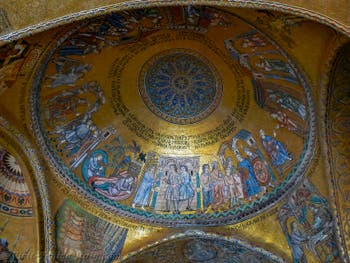
Saint Mark Basilica Mosaics St. Mark's Basilica is much more than a church, more than just a religious place.
At the same time, it is an eminently political work designed to strengthen Venice's identity and independence.
Its entire history is intimately linked to that of the Republic, from its foundation to the many constructions and reconstructions that lead to the Basilica of St. Mark as we know it today.
The Body of Saint Mark in Venice
The year 828 is a key date in the history of Venice. That year, the body of St. Mark was stolen by two Venetian merchants from Alexandria, Egypt and brought triumphantly to Venice.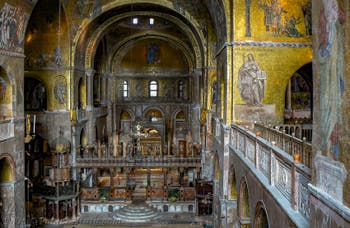
Saint Mark Basilica Apse's Mosaics It is necessary to know that an ancient legend relating to Saint Mark was part of Aquileia, a city close geographically to Venice but located on the mainland and above all affiliated with the Germanic Empire.
Aquileia, on a religious level, was then in open conflict with Grado.
In strong opposition to the Germanic Empire symbolised by Aquileia, Grado represents the Maritime Venice, linked to the Eastern Empire.
The fact that Saint Mark's body is transported to Venice is, therefore, an element of power and religion. Venice thus seizes the legend previously prevailed by the rival Aquileia.
Grado will be designated by Pope Leo IX, in 1053, “New Aquileia”, head and metropolis of all Veneto and Istria.
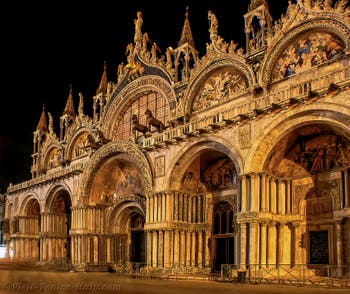
Saint-Mark Basilica by night And this legend of Saint Mark, "stolen" from Aquileia, Venice will politically and religiously use it and embellish it for its sole benefit during the centuries that followed. The myth is born!
Venice St. Mark Basilica Birth Certificate
The birth certificate of St. Mark's Basilica takes place in 829.It is the will of Doge Giustiniano Partecipazio who made a legacy intended to build, in honour of Saint Mark, a basilica that will receive his body.
Partecipazio also specified that this basilica would have to be built on the territory of San Zaccaria.
As such, let us remind that the church and convent of Zaccaria had been built before the church of St. Mark by the same doge.
St. Mark Basilica: Deliberately Byzantine
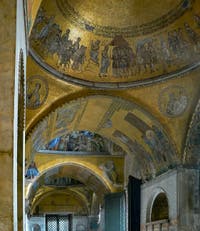
Atrium's Mosaics To understand why St. Mark's Basilica is so Byzantine, it is also worth knowing that Giustiniano Partecipazio, the legatee and first father of the basilica, was the holder of a position in Constantinople when he was elected doge.
The church of San Zaccaria was built with the help of Basileus Leo V, Emperor of Byzantium, who financed the works and sent artisans and artists to Venice to build it.
Moreover, thanks to the remains of Saint Mark, Venice would be able to assert not only its preeminence over Aquileia but subsequently to Grado herself.
Obviously, the basilica of St. Mark, by adopting a deliberately Byzantine form, reinforced in the eyes of all the unique grandeur that Venice wanted to impose in the world of that time.
St. Mark's Basilica: a Political Symbol
St. Mark Basilica was used as a symbol of the political independence of Venice.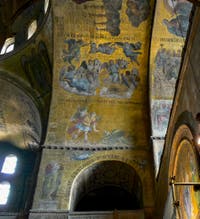
Saint-Mark Apse's Mosaics The posture of Venice in building St. Mark is, therefore, as religious as it is political.
It is unbelievable that for centuries, the basilica of Saint Mark, an eminently sacred place since containing the body of one of the four evangelists, did not depend on the church and, therefore, on the Pope.
The dean of the basilica and the clergy members were appointed only by the Republic of Venice, without any control on the part of Rome.
The Patriarchate of Grado, obtained in 1053, as we have seen above, was then transferred to Venice in 1451.
This patriarchate is still a religious exception today because it is one of the four patriarchates ever created within the Catholic church.
The competition between Saint Theodore and Saint Mark as Venice's Patron
It seems, moreover, that the first patron saint of Venice would have been Saint Theodore, who was a kind of Byzantine religious proconsul.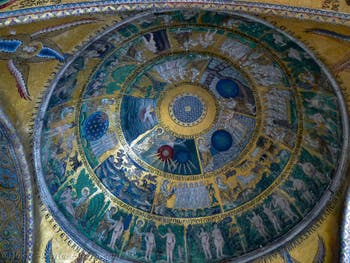
Mosaic of the creation of the world And until the fire of 976, which destroyed in part the first St. Mark's Basilica, it was built up against the church of St. Theodore, which will be razed after the said fire.
Indeed, until the end of the twelfth century, the two Saints were honoured in “equal shares“ by Venice.
Saint Mark the Oriental and his legend
St Mark's origins are also a decisive element in enabling Venice to assert its independence.If Saint Theodore was Byzantine, St Mark reached Venice directly from the Orient, coming from Alexandria in Egypt.
Here was a patron saint for Venice who had the advantage of not being directly affiliated with Rome or Byzantium.
Building a legend, a founding myth for Venice, a unique myth, tailor-made for Venice, is easier since it is based on that Saint Mark does not depend, territorially speaking, on either of the other two empires bordering Venice.
The Dream of St Mark
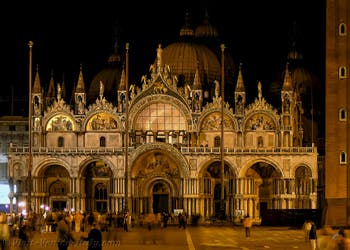
Saint-Mark Basilica by Night Venetian legend says that Saint Mark had a dream in which an angel told him that his final destination would be... Venice!
And the angel's words are, of course, immortalised in many places on the walls of Venice:
“Pax tibi Marce, Evangelista meus” - “Peace be with you, Mark my Evangelist”.
The legend of Saint Mark is also represented on the central portal of the basilica, where one can see a sculpture depicting a sleepy-bearded man.
This is, of course, Saint Mark making his premonitory dream, his “praedestinatio”.
Art Story Saint Mark's Body | History | Byzantine | Domes and Horses
Saint-Mark Art Story | Location | Opening Hours Tickets | Authorizations
Back to Top of Page

